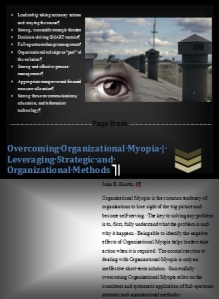At 2:30 pm, Central Time, on June 27, 2015, KS Project, Overcoming Organizational Myopia lifted off. Overcoming Organizational Myopia will be a new nonfiction book about successfully breaking through stovepiped organizations to obtain organizational effectiveness.
https://www.kickstarter.com/projects/1551087231/overcoming-organizational-mypoia
The Short Story: I discovered that it really does not matter what company or organization I work with, they all have stovepipes. What I learned is that they are a product of human nature. The problem is that everyone wants to “break down the silos” as the typical management response. Unfortunately, this NEVER works! All you do is cause confusion and drive unproductivity as the people in your business seek to rebuild the stovepipes that make them feel secure. This book is about breaking through the stovepipes to become an effective and efficient organization. It respects the stovepipes and teaches you how to navigate through them using a consistent and systematic application of full-spectrum strategic and organizational methods. The book is designed to provide you with situational examples so you can self-diagnose your organization. Across nine areas, the book helps you identify problem areas and, like a business doctor, treat the root causes with solid business solutions.





